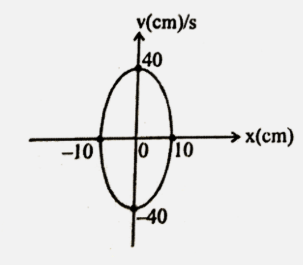The displacement of a particle executing simple harmonic motion is given by y=A0+Asinωt+Bcosωt. Then the amplitude of its oscillation is given by
A+B
A0+√A2+B2
√A2+B2
√A20+(A+B)2
The correct Answer is:C
To solve the problem, we need to find the amplitude of the oscillation given the displacement equation of a particle executing simple harmonic motion (SHM):
y=A0+Asin(ωt)+Bcos(ωt)
1. Identify the Terms:
The displacement equation consists of three terms: a constant term A0, a sine term Asin(ωt), and a cosine term Bcos(ωt).
2. Rewrite the Cosine Term:
We can express the cosine term in terms of sine to combine the sine and cosine components. The cosine function can be rewritten as:
Bcos(ωt)=Bsin(ωt+π2)
This allows us to express both components in terms of sine.
3. Use the Principle of Superposition:
The total displacement can be viewed as the superposition of two waves:
y=A0+Asin(ωt)+Bsin(ωt+π2)
This indicates that we have two oscillatory components.
4. Calculate the Resultant Amplitude:
The resultant amplitude R of the two sine components can be calculated using the formula:
R=√A2+B2
This formula arises from the Pythagorean theorem, considering the two components as perpendicular vectors in a phase space.
5. Final Amplitude Expression:
The amplitude of the oscillation is given by the resultant amplitude R:
R=√A2+B2
The constant term A0 does not affect the amplitude of the oscillation but represents a shift in the equilibrium position.
Conclusion:
Thus, the amplitude of the oscillation is:
Amplitude=√A2+B2
The displacement equation consists of three terms: a constant term A0, a sine term Asin(ωt), and a cosine term Bcos(ωt).
We can express the cosine term in terms of sine to combine the sine and cosine components. The cosine function can be rewritten as:
Bcos(ωt)=Bsin(ωt+π2)
This allows us to express both components in terms of sine.
The total displacement can be viewed as the superposition of two waves:
y=A0+Asin(ωt)+Bsin(ωt+π2)
This indicates that we have two oscillatory components.
The resultant amplitude R of the two sine components can be calculated using the formula:
R=√A2+B2
This formula arises from the Pythagorean theorem, considering the two components as perpendicular vectors in a phase space.
The amplitude of the oscillation is given by the resultant amplitude R:
R=√A2+B2
The constant term A0 does not affect the amplitude of the oscillation but represents a shift in the equilibrium position.
Thus, the amplitude of the oscillation is:
Amplitude=√A2+B2
Similar Questions
Knowledge Check
The displacement of a particle executing simple harmonic motion is given by y=4sin(2t+ϕ). The period of oscillation is
A2/πBπ/2CπD2πThe differential equation of a particle executing simple harmonic motion along y-axis is
Ad2ydt2+ω2y=0Bd2ydt2+ω2y2=0Cd2ydt2−ω2y=0Ddydt+ωy=0The displacement of a particle executing simple harmonic motion is given by
x=3sin(2πt+π4)
where x is in metres and t is in seconds. The amplitude and maximum speed of the particle isA3m, 2πms−1B3m, 4πms−1C3m, 6πms−1D3m, 8πms−1
A simple harmonic motion is represented by x(t)=sin2ωt−2cos2ωt. The angular frequency of oscillation is given by
View SolutionThe displacement of a particle performing simple harmonic motion is given by, x=8sinωt + 6 cos ωt, where distance is in cm and time is in second. What is the amplitude of motion?
View SolutionFor a particle executing simple harmonic motion, the acceleration is -
View SolutionThe plot of velocity (v) versus displacement (x) of a particle executing simple harmonic motion is shown in figure. The time period of oscillation of particle is :-

View SolutionThe displacement of a particle of mass 3g executing simple harmonic motion is given by x=3sin(0.2t) in SI units. The kinetic energy of the particle at a point which is at a displacement equal to 13 of its amplitude from its mean position is
View Solution